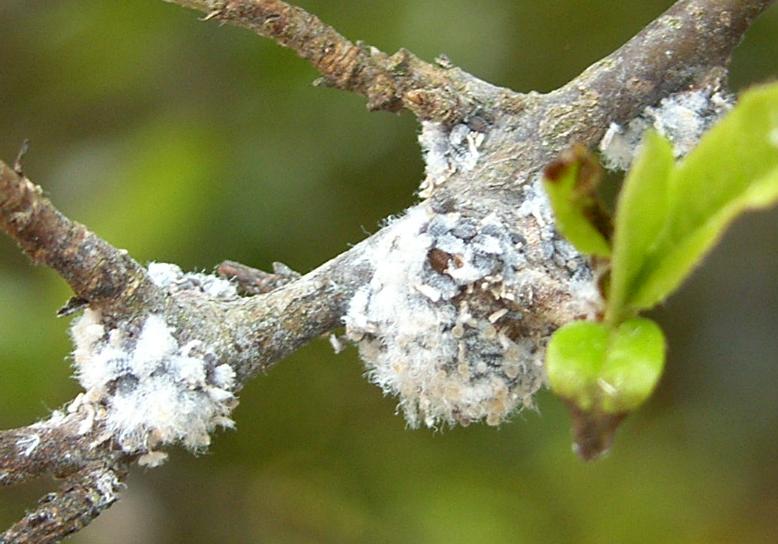
A colony of Woolly Aphids on a Pyracantha bush.
| HOME | SITEMAP | SEARCH | ARTICLES |

Woolly Aphids get their name from the waxy excretion they carry as a form of protection from predators. At first inspection this may make them appear to be a fungus. They usually appear in the spring on some fruit trees and shrubs such as apple, pear, prunus, pyracantha, cotoneaster, elm, hawthorn and mountain ash. As with all aphids they are sucking the sugary sap, but their action causes a callous-like lump or gall to grow, which provides better access to their reward. These remain after in infestation has gone and affected branches do not usually regain their vigour so if possible they should be pruned out. If a plant is badly infested it may never recover properly and it can be best to replace it.
The adults are about 2mm long and a pinkish-brown colour, although they appear to be white with their waxy protection. They overwinter as young in crevices and cracks in the bark, emerging in the spring forming rapidly growing colonies on new shoots and at pruning cuts where the sap is more readily available. This causes weak growth of the plant and the leaves may fall due to the lack of sap to keep them functioning. They also excrete honeydew which coats the leaves and Sooty Mould may start to grow.
Each adult can produce up to five live young per day and after a few generations winged adults develop to spread to new branches and nearby trees.
There are other Woolly Aphids such as the Beech Woolly Aphid which is specific to Beech trees and infest the leaves.
Treatments
- Check susceptible plants regularly for infestations and treat pruning cuts with a wound sealant to remove this source of sap.
- The colonies can be rubbed away with a brush and soapy water.
- A forceful jet of water will remove the bulk of a colony.
- Use a cloth soaked in metholated spirit to 'brush' them off.
- A spray prepared from a couple drops of washing-up liquid to a gallon of water as an acceptable organic method of control; so are insecticidal soaps made from plant fatty acids. Avoid spraying in sunshine to prevent scorching the plant.
- Encourage birds such as Blue Tits to the area by supplying feeders and nest boxes.
- Place Ladybird and Lacewing shelters nearby to provide winter quarters for them. These can be specially made structures or bunches of dried, hollow stems tied together and placed horizontally in a sheltered spot.
- Daisy-like yellow flowers attract insects such as Hoverflies and Lacewings and their larvae feed on aphids.
- Biological controls need a constant supply to survive, so there will always be a low-level presence, hopefully these will be on nearby wild plants. Ladybirds are nocturnal so if they are feeding during the day the number of aphids may be low.
- An acceptable organic spray is made from an extract of the Neem tree called Azadiractin
- For chemical control use *imidacloprid, pyrethroids or bifenthrin - spray as late in the day as possible to avoid Ladybirds and other friendly creatures. Follow directions and precautions given on packs, especially if treating fruit trees.
*Imidacloprid is a neonicotinoid compound and these have been suggested as as causative agents of colony collapse disorder (CCD) in Honeybees.
Back to GARDEN CREATURES